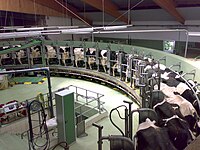
Photo from wikipedia
Diarrhea is the primary cause of morbidity and mortality in dairy calves. Many cases of diarrhea in calves are treated with antimicrobials, increasing the risk of antimicrobial resistance, therefore, creating… Click to show full abstract
Diarrhea is the primary cause of morbidity and mortality in dairy calves. Many cases of diarrhea in calves are treated with antimicrobials, increasing the risk of antimicrobial resistance, therefore, creating a need for alternative therapies. The objective of this study was to evaluate the effects of feeding spray-dried maternal derived bovine colostrum replacer at the onset of diarrhea on calf growth and duration and severity of the disease in preweaning dairy calves. At a calf-raising facility in southern Ontario, calves were scored for fecal consistency twice daily on a scale of 0 to 3 and enrolled into the trial when they had 2 consecutive fecal scores of 2 (runny or spreads readily) or one fecal score of 3 (liquid consistency, splatters). Calves were then randomly allocated to receive one of the following 3 treatments: (1) control (CON; n = 35): 8 feedings over 4 d of 2.5 L of milk replacer at a concentration of 130 g/L (26% crude protein and 17% fat); (2) short-term colostrum supplementation (STC; n = 35): 4 feedings over the first 2 d of 2.5 L of a mixture of milk replacer at 65 g/L and bovine colostrum replacer at 65 g/L (26% IgG and 14.5% fat) followed by 4 feedings over 2 d of 2.5 L of milk replacer at a concentration of 130 g/L; or (3) long-term colostrum supplementation (LTC; n = 38): 8 feedings over 4 d of 2.5 L of a mixture of milk replacer at 65 g/L and bovine colostrum replacer at 65 g/L. Serum IgG was determined at arrival to the facility and body weight, days to enrollment since facility arrival, and severity of diarrhea were recorded at enrollment. Daily health exams evaluating fecal consistency were performed for 28 consecutive days after enrollment and body weight was measured at d 0, 1, 2, 3, 4, 7, 14, 21, 28, 42 and 56 after enrollment. The median days to resolution of a case of diarrhea was 3.5 d (range: 0.5-11.5 d), 2.75 d (range: 0.5-11.0 d), and 2.75 d (range: 0.5-7.0 d) in CON, STC, and LTC, respectively. Using a Cox proportional hazards model, it was found that calves in LTC group had faster resolution of diarrhea compared with calves in the CON group. In addition, there was an association between both days to enrollment since facility arrival and body weight and resolution of diarrhea, where calves who were at the facility longer before enrollment and heavier at the onset of diarrhea, resolved diarrhea quicker. In addition, calves with a fecal score of 3 at enrollment took longer to resolve their case of diarrhea. With respect to body weight, a linear regression model was built and found that over the 56 d following enrollment calves in the LTC treatment grew 98 g/d more than calves in the CON group. These results suggest that bovine colostrum may be an effective therapy for diarrhea in preweaning calves.
Journal Title: Journal of dairy science
Year Published: 2022
Link to full text (if available)
Share on Social Media: Sign Up to like & get
recommendations!